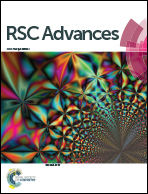Gadolinium-labelled iron/iron oxide core/shell nanoparticles as T1–T2 contrast agent for magnetic resonance imaging†
Abstract
Magnetic resonance imaging (MRI) is indispensable and powerful in modern clinical diagnosis and has some advantages such as non-invasiveness and high penetration depth. Furthermore, dual T1–T2 MR imaging has attracted crucial interest as it can decrease the risk of pseudo-positive signals in diagnosing lesions. And it's worth nothing that the dual-mode MR imaging displays a vital platform to provide relatively comprehensive diagnosis information and receive accurate results. Herein, we report a dual T1–T2 MR imaging contrast agent (CA) grounded on the iron/iron oxide core/shell nanomaterials conjugated with gadolinium chelate. The Gd-labeled Fe@Fe3O4 NPs reveal the feasibility to utilize them to serve as a dual T1–T2 MR imaging CA, and the relaxivity results in a 0.5 T MR system showed a longitudinal relaxivity value (r1) and transverse relaxivity value (r2) of 7.2 mM−1 s−1 and 109.4 mM−1 s−1, respectively. The MTT results demonstrate the Gd-labeled Fe@Fe3O4 NPs have no obvious cytotoxicity and a good compatibility. The in vitro and in vivo MRI generated a brighter effect and darkening in T1-weighted MR imaging and T2-weighted images, respectively. The results clearly indicate that Gd-labeled Fe@Fe3O4 NPs have potential as a magnetic resonance imaging contrast reagent.



 Please wait while we load your content...
Please wait while we load your content...